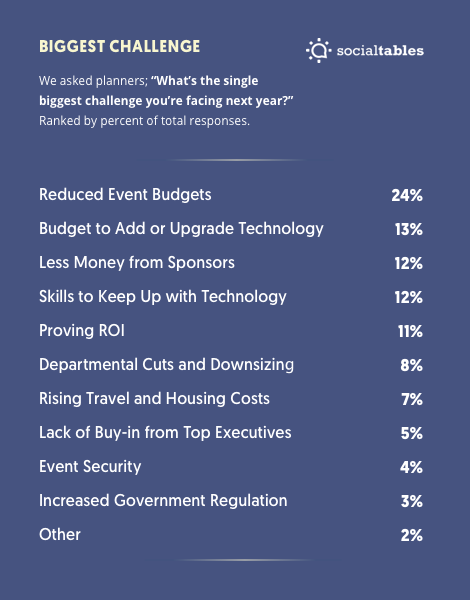Recent studies have shown that demand for meetings and events is growing and is expected to continue its rise. But according to a new survey from Social Tables, 24 percent of respondents predict that a reduced event budget will be the biggest challenge they face in 2017. Planners are anticipating taking on more events with shrinking budgets.

Every planner knows that the size of a budget can mean the difference between a spectacular event and a lackluster one. A tiny budget can force planners to get creative and think outside the box, but it can also mean being forced to choose between the perfect venue and a tolerable one.
So what’s a planner to do? Social Tables offers these and other strategies to prove ROI and get the right-size budget for your event.
1. Ask! It seems obvious, but many professionals struggle to initiate money talks. You know exactly what you need, so it’s time to set a date, make an appointment and come prepared with data and reports to back up your argument. Clearly communicate what you need, and you may be surprised at the outcome.
2. Do your research. As the saying goes, knowledge is power. Find out what’s going on with the budgets in other departments; is the company cutting back on events while spending more on other things? Also, get an idea of what’s happening in the rest of the industry. Are other planners facing the same budgetary issues as you? Is demand for meetings expected to grow? Knowing what to expect will give you more leverage at the negotiating table.
3. Don’t forget the data. As we’re seeing more and more, data is king. That’s why it’s important for planners to find ways to measure and quantify their results. There are many new event technology tools that enable corporate meeting planners to analyze event success, attendee engagement and ROI in quantifiable ways. These metrics will be crucial to support your decisions and budget requests.
4. Predict the future. Identify trends in your events, as well as across the industry, and you should be able to accurately set goals for the upcoming year. Having clear and informed goals will help planners design long-term strategies and make smart decisions for their events—and the size of their budget.
5. Demonstrate value. Other departments in your company might not understand how they can benefit from corporate meetings, but you can easily get them on your side. You can use a casual “lunch and learn” session to share your recent successes, get colleagues’ feedback and show them what they can gain from these events.
6. Explain why. It will be much easier to get the resources you need if you can clearly show why you need them. Break down your reasons into specific categories. Explain that email marketing boosts registration rates, so your team needs additional training to make the most of this technology. If you want to invest in event technology, show them exactly how event check-in apps will streamline attendee experiences and cut down on the manpower needed at events.
7. Focus on your strengths. With many planners experiencing more demands on their time than ever, it can be hard to juggle all of the tasks that need to get done. To maintain your focus, identify your team’s strengths, along with any tasks that should be outsourced or eliminated.
For more tips on negotiating event budgets, as well as other valuable industry insights, see Social Tables’ Events Budget Report.




